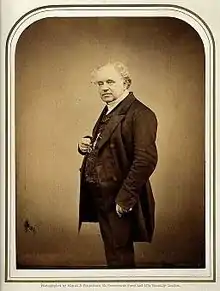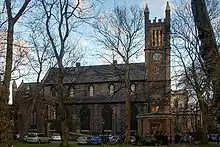Thomas Leverton Donaldson
Thomas Leverton Donaldson (19 October 1795 – 1 August 1885) was a British architect, notable as a pioneer in architectural education, as a co-founder and President of the Royal Institute of British Architects and a winner of the RIBA Royal Gold Medal.

Life

.jpg.webp)
Donaldson was born in Bloomsbury Square, London, the eldest son of architect, James Donaldson. His maternal uncle was Thomas Leverton (1743–1824),[1] a distinguished architect sometimes credited with the south range of Bedford Square in London.[2]
Donaldson travelled overseas after leaving school, obtaining a clerical job with a merchant on the Cape of Good Hope before volunteering for an expedition to attack the French-controlled island of Mauritius. Once back in London, he was employed in his father's office, before visiting Italy and Greece to broaden his experience. He designed 4 Hamilton Place for the Earl of Lucan. His first significant work was the church of Holy Trinity in South Kensington, London (built 1826-1829).[3]
With Jacques Ignace Hittorff and Charles Robert Cockerell, Donaldson was also a member of the committee formed in 1836 to determine whether the Elgin Marbles and other Greek statuary in the British Museum had originally been coloured (see Transactions of the Royal Institute of British Architects for 1842).
Donaldson reworked substantial sections of the Wilkins building at University College London (UCL), and designed its Flaxman Gallery and library buildings. He also designed All Saints Church in Gordon Street, London, and was involved with the Great Exhibition of 1851.
Donaldson pioneered the academic study of architecture and in 1841 became the first Professor of Architecture at University College London - a post he retained until 1865. He was also a co-founder of the Royal Institute of British Architects in 1834,[4] and continued as its honorary secretary until 1839, then as its foreign secretary for a further twenty years. He designed the institute's Mycenean lions medal and the motto ‘Usui civium, decori urbium'.[5] He was awarded the institute's royal gold medal in 1851 and was its president from 1863 to 1864. [6] He was described by the Prince of Wales in 1879 as the father of the Institute and of the profession'.[7]
Donaldson died in Upper Bedford Place, Bloomsbury, and is buried in Brompton Cemetery, London.
His nephew was the artist Andrew Brown Donaldson.
References
- Thomas Leverton's memorial at Waltham Abbey, Essex, bears the inscription "T.Leverton Donaldson, Nephew And Godson, Arc't." (The Memorial Inscriptions in the Church of the Holy Cross and Saint Lawrence at Waltham Abbey, Waltham Abbey Historical Society, Millennium Project No. 22, additions and corrections slip, 2009.)
- http://www.htb.org.uk/history/ Holy Trinity, Brompton
- Port, M.H. "Founders of the Royal Institute of British Architects (act. 1834–1835)". Oxford Dictionary of National Biography (online ed.). Oxford University Press. (Subscription or UK public library membership required.)
- RIBA lions medal and motto
- Oxford Dictionary of National Biography,Oxford University Press, 2004. Accessed 10 Feb 2014.
- Art UK
External links
- Oxford Dictionary of National Biography, Oxford University Press, 2004
- Dictionary of Scottish Architects
- Portrrait of Thomas Leverton Donaldson (1795–1885), PRIBA
- Albert Memorial, Thomas Leverton Donaldson
- Donaldson, Thomas Leverton, "'Architectural maxims and theorems in elucidation of some of the principles of design and construction: and lecture on the education and character of the architect (1847)